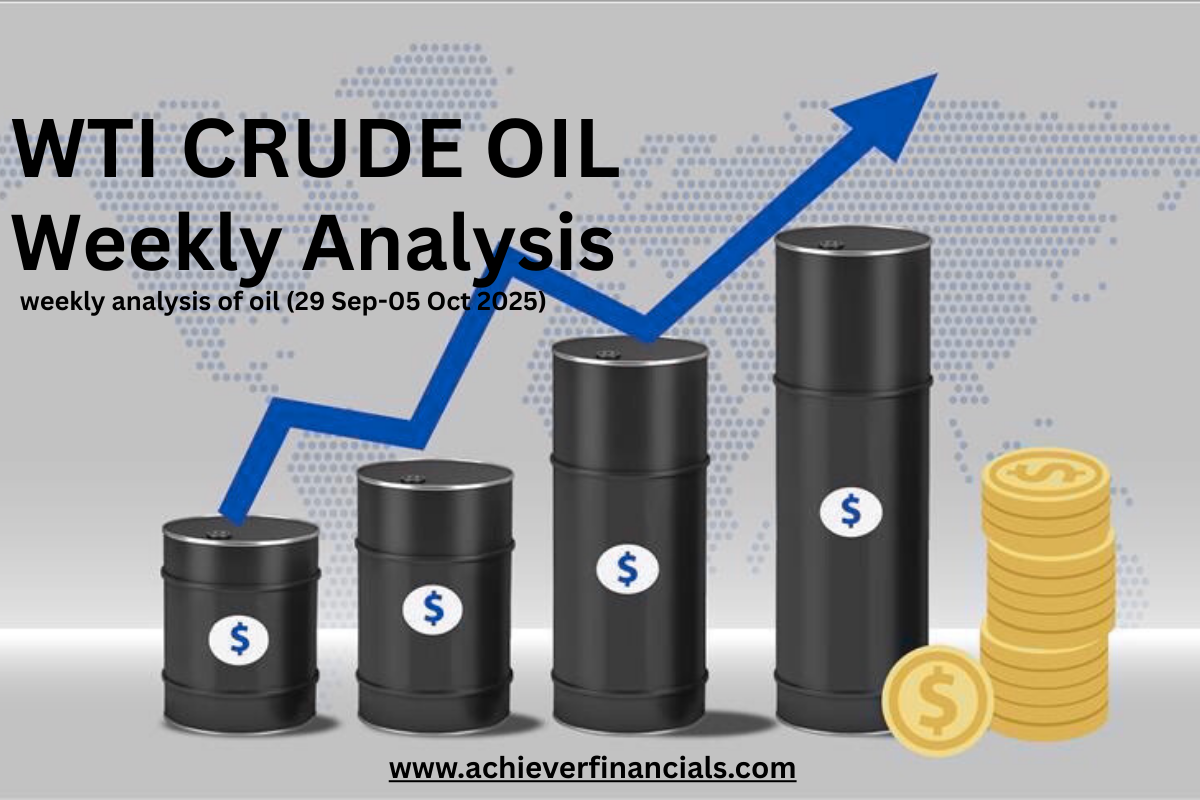WTI Crude Oil Weekly Forecast
September 29 – October 5, 2025
September 26, 2025 Achiever Financials Ltd Analysis Team
Executive Summary
The Achiever Financials Ltd Analysis Team anticipates a cautiously optimistic outlook for West Texas Intermediate (WTI) crude oil prices next week, with the benchmark expected to trade in a narrow range of $64.50 – $66.50 per barrel. This forecast is underpinned by stabilising global supply dynamics and lingering geopolitical tensions in key producing regions, offset by softening demand signals from major economies. Current spot prices stand at approximately $65.19 per barrel as of market close on September 26, 2025. We recommend a neutral-to-bullish stance for short-term traders, with close monitoring of U.S. inventory data releases mid-week.
Current Market Overview
WTI crude oil concluded the week on a modestly positive note, rebounding from intraday lows near $64.00 to settle at $65.19, marking a 0.32% gain from the prior session. This uptick reflects a partial recovery from mid-September’s dip below $63.00, driven by renewed buying interest amid escalating Middle East uncertainties. Year-to-date, WTI has fluctuated within a $60–$70 corridor, influenced by OPEC+ production adjustments and U.S. shale output resilience. As of September 26, futures for the October contract are trading at $65.27, with implied volatility at subdued levels indicating limited near-term catalysts for sharp moves.
| Metric | Value (Sep 26, 2025) | Weekly Change |
|---|---|---|
| WTI Spot Price | $65.19/bbl | +0.32% |
| October Futures | $65.27/bbl | +0.29% |
| 1-Month High/Low | $66.88 / $62.64 | N/A |
| Implied Volatility | 25.4% | -1.2% |
Key Influencing Factors
Several macroeconomic and geopolitical elements are shaping the near-term trajectory for WTI prices:
1. Supply Constraints and OPEC+ Dynamics: OPEC+ is expected to maintain its voluntary production cuts through Q4 2025, supporting prices amid forecasts of global refinery throughputs averaging 83.5 million barrels per day (mb/d). However, non-OPEC supply growth, particularly from U.S. shale (projected at 13.42 million bbl/d for 2025), could cap upside potential.
2. Demand Outlook and Economic Signals: Global oil demand growth is forecasted to slow to 540 kb/d in 2026, reflecting weaker industrial activity in China and Europe. U.S. gasoline demand remains seasonally robust heading into fall, but broader economic headwinds—such as potential Federal Reserve rate adjustments—may temper consumption.
3. Geopolitical Risks: Heightened tensions in the Middle East, including recent escalations involving Iran and proxy conflicts, have fueled a short-term risk premium, contributing to the September 23–24 surge. Any de-escalation could trigger a pullback, while sustained disruptions might push prices toward $68.00.
4. Inventory Levels: U.S. crude stockpiles are anticipated to draw down modestly next week per EIA estimates, providing a supportive floor. OECD strategic reserves continue to influence sentiment, with current levels acting as a buffer against volatility.
These factors collectively point to a balanced market, with supply-demand equilibrium preventing extreme deviations.
Technical Analysis
From a technical perspective, WTI has reversed upward from the key support at $61.70, signaling potential for a test of resistance near $65.00–$66.00 in the coming sessions. The 50-day moving average at $64.20 provides near-term support, while the RSI (14-period) at 52 indicates neutral momentum, avoiding overbought territory. A bearish divergence in commercial positioning suggests underlying caution, with net shorts increasing by 21% in recent CFTC data.
Should prices breach $63.40 to the downside, a retest of the pennant lower trendline near $62.00 becomes likely, invalidating the bullish reversal. Conversely, a close above $66.50 could open the door to $68.00. Our proprietary Elliott Wave model aligns with a corrective wave C targeting $65.50 by mid-week.
Key Levels to Watch:
– Resistance: $66.00 (psychological), $66.50 (recent high)
– Support: $64.50 (50-day MA), $63.40 (trendline)
Forecast for September 29 – October 5, 2025
Based on the interplay of fundamentals and technicals, we project WTI to open the week near $65.20 and consolidate within $64.50–$66.50. Upside scenarios (60% probability) could see prices averaging $66.00 amid positive inventory surprises or escalated geopolitical headlines. Downside risks (40% probability) may pull averages to $64.00 if demand data disappoints.
| Metric | Value (Sep 26, 2025) | Weekly Change |
|---|---|---|
| WTI Spot Price | $65.19/bbl | +0.32% |
| October Futures | $65.27/bbl | +0.29% |
| 1-Month High/Low | $66.88 / $62.64 | N/A |
| Implied Volatility | 25.4% | -1.2% |
This aligns with broader 2025 consensus forecasts of $64.65 annual average, per Reuters polling, suggesting limited directional bias in the short term.
Risks and Recommendations
Upside Risks: Accelerated supply disruptions or stronger-than-expected U.S. economic data could propel prices beyond $67.00.
Downside Risks: Easing Middle East tensions or hawkish Fed rhetoric may accelerate the EIA’s projected Q4 decline toward $59.00 (Brent equivalent).
Trading Recommendations:
– Long Positions: Enter above $65.50 with stops at $64.50; target $66.50.
– Short Positions: Initiate below $64.00 with stops at $64.80; target $63.00.
– Hedgers: Roll October contracts into November to mitigate contango exposure.
Conclusion
WTI crude oil enters next week in a state of equilibrium, with modest upside potential tempered by demand uncertainties. The Achiever Financials Ltd team advises vigilance around Wednesday’s EIA inventory report and Friday’s non-farm payrolls release, both of which could catalyse volatility. For tailored advisory services or portfolio hedging strategies, contact our commodities desk.
Disclaimer: This report is for informational purposes only and does not constitute investment advice. Past performance is not indicative of future results. Achiever Financials Ltd assumes no liability for actions taken based on this analysis.








